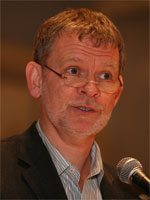What Is the Most Daring, Audacious, and Successful Grant of the Past 100 Years?
Resource type: News
Philanthropy Magazine | [ View Original Source (opens in new window) ]
A symposium of philanthropic leaders
To mark the 100th anniversary of the Carnegie Corporation, we asked several philanthropic leaders about the most audacious grants of the past century—and what grants made today will be talked about 100 years hence.
—THE EDITORS
* * *
Ted Turner’s shock announcement in 1997 that he was going to give the United Nations $1 billion—made almost on a whim and without even knowing if the international body could accept his gift—was certainly audacious and daring. Its success is harder to measure. Turner says that he “feels” the U.N. is stronger as a result, but that may not be the true test. The real impact of his gift was to make philanthropy a vocation for the world’s super-rich. “Bill Gates told me once, ‘Thank you for drawing my attention to philanthropy,’” Turner says. If that is the case, his $1 billion has unlocked tens more from Gates alone and hundreds of billions from the donors Gates is inspiring through his Giving Pledge initiative.
—Matthew Bishop and Michael Green
Co-authors, Philanthrocapitalism and The Road From Ruin
 There have been so many advances over the past century—medical breakthroughs, scientific, transportation and technological advances, even the advent of space flight—but it’s tough to credit their success to philanthropy, since most were the result of government support or private industry. Among those important innovations that were advanced by philanthropic dollars: the polio vaccine, the creation of the public library system, public broadcasting, our 911 emergency system, and the discovery of insulin to treat diabetes. These were all incredibly bold, revolutionary breakthroughs that improved the quality of life for people in America and in some cases, around the world.
There have been so many advances over the past century—medical breakthroughs, scientific, transportation and technological advances, even the advent of space flight—but it’s tough to credit their success to philanthropy, since most were the result of government support or private industry. Among those important innovations that were advanced by philanthropic dollars: the polio vaccine, the creation of the public library system, public broadcasting, our 911 emergency system, and the discovery of insulin to treat diabetes. These were all incredibly bold, revolutionary breakthroughs that improved the quality of life for people in America and in some cases, around the world.
—Eli Broad
Co-founder, Eli and Edythe Broad Foundation
Asset size: $1.4 billion
I believe that Andrew Carnegie’s commitment to creating libraries as quasi-public utilities in every community still stands as the most audacious, daring, and successful grant of the past 100 years. While there were many brilliant initiatives—including Julius Rosenwald’s funding of 5,000 schools for African Americans in the South, the Rockefeller Foundation’s commitment to sustainable agriculture in the developing world, and so many others—providing access to written content, regardless of affordability, was a profoundly farsighted vision. Carnegie and others of his time saw new ways to conduct the business of providing for the betterment of humankind.
—Charles Bronfman
Founder and chairman, Andrea and Charles Bronfman Philanthropies
Former co-chairman of Seagram Company
 Without question, the most audacious, daring, and successful individual and foundation grants of the past 100 years were those in support of the U.S. civil rights movement. This nonviolent movement allowed African Americans to rise from legalized second-class citizenship, to equal rights under the law, and ultimately to the election of an African-American President of the United States—all in less than 50 years. The success of the civil rights movement also legitimized nonviolent efforts to secure equal rights for American women, other people of color, and now, gays and lesbians. It is also the inspiration for advancing equal rights for tribal and ethnic groups and women worldwide.
Without question, the most audacious, daring, and successful individual and foundation grants of the past 100 years were those in support of the U.S. civil rights movement. This nonviolent movement allowed African Americans to rise from legalized second-class citizenship, to equal rights under the law, and ultimately to the election of an African-American President of the United States—all in less than 50 years. The success of the civil rights movement also legitimized nonviolent efforts to secure equal rights for American women, other people of color, and now, gays and lesbians. It is also the inspiration for advancing equal rights for tribal and ethnic groups and women worldwide.
—Emmett D. Carson
President and CEO, Silicon Valley Community Foundation
America’s second-largest community foundation
It’s nearly impossible to single out one grant, but in terms of its audacity and success, I think the W. M. Keck Foundation’s support for the W. M. Keck Observatory on Mauna Kea makes the grade. The foundation invested $144 million during the mid-to-late 1980s in groundbreaking technology that continues to shed new light on the origins of the universe. Then, as now, there were too few foundations committing large sums to unproven and risky ideas, but the payoff has been extraordinary. The telescopes have paved the way to the development of new technologies, helped train generations of astronomers, and provided answers to some of the most profound questions facing humanity.
—Robert Day
Chairman, president, and CEO, W. M. Keck Foundation
Asset size: $1 billion +
 The grant provided by the Ansari family (Anousheh, Hamid, and Amir Ansari) to the X Prize Foundation in 2001 was transformative. The donation, for about $10 million, funded the purse and operations for the largest incentive prize in recent history. In so doing, it created private initiative in a space which had been the exclusive province of government. While many donors and corporations declined to fund such a risky proposal, the Ansari family stepped in and made the competition real and successful. The results of their grant were tremendous. Their $10 million grant inspired 26 teams from 7 nations to spend over $100 million on efforts to win the prize. On October 4, 2004, SpaceShipOne—designed by Burt Rutan and financed by Microsoft co-founder Paul Allen—won the prize. But the contest continues. Since then, over $1 billion has been invested in the companies that were created for this competition.
The grant provided by the Ansari family (Anousheh, Hamid, and Amir Ansari) to the X Prize Foundation in 2001 was transformative. The donation, for about $10 million, funded the purse and operations for the largest incentive prize in recent history. In so doing, it created private initiative in a space which had been the exclusive province of government. While many donors and corporations declined to fund such a risky proposal, the Ansari family stepped in and made the competition real and successful. The results of their grant were tremendous. Their $10 million grant inspired 26 teams from 7 nations to spend over $100 million on efforts to win the prize. On October 4, 2004, SpaceShipOne—designed by Burt Rutan and financed by Microsoft co-founder Paul Allen—won the prize. But the contest continues. Since then, over $1 billion has been invested in the companies that were created for this competition.
—Peter Diamandis
Chairman and CEO, X Prize Foundation
It didn’t seem audacious at the time, but the most consequential education grant of the past century was Carnegie’s grant to Harvard in 1966 to underwrite a “faculty seminar” to analyze James Coleman’s report “on equality of educational opportunity,” released just a year earlier by what was then known as the Department of Health, Education, and Welfare. Led by Daniel Patrick Moynihan and Thomas Pettigrew, and followed by a key book by Moynihan and Frederick Mosteller, that seminar spotlighted the core Coleman finding: school resources don’t correlate with school results. This transformed America’s entire approach to K–12 education. We now focus on results—and understand that fiddling with inputs alone doesn’t much affect them.
—Chester E. Finn Jr.
President and CEO, Thomas B. Fordham Foundation
 Everyone in the country benefits daily from the Dorr Foundation’s daring grant. In 1952, John Dorr of Westport, Connecticut, wrote the Connecticut highway commissioner urging him to paint right-hand white lines on the Merritt Parkway. Dorr, a retired engineer, had built a company and a foundation but focused on traffic safety when his wife complained that bright oncoming headlights caused her (and others) to steer toward the shoulder. Dorr hypothesized that a white stripe on the outer edge of the pavement would guide drivers to see the center of their own lane and stay in it. While Connecticut dithered, Dorr’s foundation funded independent testing in four states monitored by the National Highway Safety Board. We are all safer.
Everyone in the country benefits daily from the Dorr Foundation’s daring grant. In 1952, John Dorr of Westport, Connecticut, wrote the Connecticut highway commissioner urging him to paint right-hand white lines on the Merritt Parkway. Dorr, a retired engineer, had built a company and a foundation but focused on traffic safety when his wife complained that bright oncoming headlights caused her (and others) to steer toward the shoulder. Dorr hypothesized that a white stripe on the outer edge of the pavement would guide drivers to see the center of their own lane and stay in it. While Connecticut dithered, Dorr’s foundation funded independent testing in four states monitored by the National Highway Safety Board. We are all safer.
—Claire Gaudiani
Author, Generosity Unbound
I nominate the Rockefeller Foundation’s 50-year, $600 million investment that launched the Green Revolution. The effort was initiated in 1943, through an agreement between the Rockefeller Foundation and the Mexican Department of Agriculture. Its purpose: to research ways to increase food production. The Green Revolution marked an era during which new agricultural technologies, practices, and developments spread from the industrialized world to the third world, especially India. It was a focused, strategic, and long-term investment that enabled parts of the world that were previously experiencing famine to subsequently produce surplus wheat and rice. This led to huge gains in the food supply, thereby saving millions of lives. While I recognize there were unintended consequences (e.g., disparities in access to food and some environmental degradation), I believe these are outweighed by the net benefits.
—Steven M. Hilton
President and CEO, Conrad N. Hilton Foundation
Asset size: $2 billion
 Picking the grant with the most impact in a century is a daunting, if not impossible, task. But one that continues to leave a deep mark is the 1982 John M. Olin Foundation grant to the Harvard Journal of Law and Public Policy to organize a conference on “the legal ramifications of the new federalism.” The conference was headlined by conservative legal lights like Robert Bork, Antonin Scalia, Ted Olson, and Richard Posner, and soon grew into the Federalist Society, with chapters on law school campuses around the country—the leading wedge of a conservative legal movement that shapes the federal courts to this day. I don’t agree with most of what the Federalist Society does and stands for, and even supported the establishment of its progressive counterpart, the American Constitution Society. But I admire the audacity of the grant—and its central belief that ideas drive policy, law, and society.
Picking the grant with the most impact in a century is a daunting, if not impossible, task. But one that continues to leave a deep mark is the 1982 John M. Olin Foundation grant to the Harvard Journal of Law and Public Policy to organize a conference on “the legal ramifications of the new federalism.” The conference was headlined by conservative legal lights like Robert Bork, Antonin Scalia, Ted Olson, and Richard Posner, and soon grew into the Federalist Society, with chapters on law school campuses around the country—the leading wedge of a conservative legal movement that shapes the federal courts to this day. I don’t agree with most of what the Federalist Society does and stands for, and even supported the establishment of its progressive counterpart, the American Constitution Society. But I admire the audacity of the grant—and its central belief that ideas drive policy, law, and society.
—Gara LaMarche
President and CEO, Atlantic Philanthropies
Asset size: $2.2 billion
Spending down by 2020
Sometimes, being audacious, daring, and ultimately successful has less to do with finding a single grant aimed at a silver-bullet solution, and more to do with supporting a movement leading us toward solutions to complex problems. These types of grants can help shine a light upon a problem. They require foundations to have staying power. They help us dare to work toward progress on complicated issues, even when progress might feel slow. A great example is the grant made by the Rockefeller Foundation, the MacArthur Foundation, and the Pew Charitable Trusts to form the Energy Foundation, which our foundation later joined. In 1990, these foundations, each with newly appointed presidents, jointly committed $100 million over 10 years to advance clean, sustainable energy, especially energy efficiency and renewable energy sources like wind and solar power. The Energy Foundation partnership took off, opening an office in China in 1999. It now has more than a dozen foundation partners and a strong track record of advancing clean energy solutions.
—Carol Larson
President and CEO, David and Lucile Packard Foundation
Seventh-largest U.S. foundation by asset size
 John D. Rockefeller was the most extraordinary businessman and philanthropist of the last 100 years. The most daring and generous grant was his creation of the University of Chicago, from scratch, without putting his name on it.
John D. Rockefeller was the most extraordinary businessman and philanthropist of the last 100 years. The most daring and generous grant was his creation of the University of Chicago, from scratch, without putting his name on it.
—Lewis E. Lehrman
Co-founder, Gilder Lehrman Institute of American History
National Humanities Medal recipient, 2005
Andrew Carnegie’s support for public libraries was one of the most successful philanthropic initiatives in history. Carnegie believed that the best philanthropy was a “hand up” and not a handout. These libraries were open to anyone who wanted to improve his or her condition and quality of life through self-education. The community was required to provide a site and commit to an annual operating budget that was equal to at least 10 percent of the cost of the building. Carnegie’s grants leveraged public funding to help millions of people improve their own lives. This is high-impact philanthropy at its finest.
—H. F. (“Gerry”) Lenfest
Co-founder, Lenfest Foundation
Giving Pledge signatory
 Too little remembered and even less celebrated, American foundations achieved their finest hour at the height of the Cold War. Quietly partnering with the federal government (often the CIA), some 39 foundations—including Ford, Rockefeller, and Carnegie—funded intellectuals and artists to make the moral case for democratic capitalism. The projects funded ranged widely: beneficiaries included Radio Free Europe, the Congress for Cultural Freedom, and Irving Kristol’s Encounter. The cumulative effect was to help arrest the advance of Soviet propaganda. It was the nation’s greatest public-private partnership, and one which ultimately helped consign Soviet communism, the great malignant scourge of the 20th century, to the trash-heap of history.
Too little remembered and even less celebrated, American foundations achieved their finest hour at the height of the Cold War. Quietly partnering with the federal government (often the CIA), some 39 foundations—including Ford, Rockefeller, and Carnegie—funded intellectuals and artists to make the moral case for democratic capitalism. The projects funded ranged widely: beneficiaries included Radio Free Europe, the Congress for Cultural Freedom, and Irving Kristol’s Encounter. The cumulative effect was to help arrest the advance of Soviet propaganda. It was the nation’s greatest public-private partnership, and one which ultimately helped consign Soviet communism, the great malignant scourge of the 20th century, to the trash-heap of history.
—Christopher Levenick
Editor-in-Chief, Philanthropy
It is difficult to single out one grant, given the many accomplishments of American philanthropy over the past 100 years. The last century has been extraordinary, with scores of daring and successful achievements in many broad areas—global health, poverty, social justice, education, and the arts—by a few key foundations such as Ford, Rockefeller, and the Carnegie Corporation. There have also been successful grants that were not necessarily audacious. I’d cite the Andrew Mellon Foundation for the constancy of its support of the humanities, which has been so crucial to the success of higher education and cultural institutions in the United States.
—Deborah Marrow
Interim president and CEO, J. Paul Getty Trust
Asset size: $9.3 billion
 The most daring and successful (and intelligent) grant of the past 100 years was not a grant. It was the Ford Foundation’s guarantee of $800,000 in commercial loans that allowed Muhammad Yunus to prove his microfinance concept on a large scale. More foundations should start looking at the fact that, if they want to have real impact, they have to stop looking at programs and start looking at the power of the assets in their corpus, which can be used to capitalize new revenue engines. Stop funding programs—and start funding the things that can fund programs.
The most daring and successful (and intelligent) grant of the past 100 years was not a grant. It was the Ford Foundation’s guarantee of $800,000 in commercial loans that allowed Muhammad Yunus to prove his microfinance concept on a large scale. More foundations should start looking at the fact that, if they want to have real impact, they have to stop looking at programs and start looking at the power of the assets in their corpus, which can be used to capitalize new revenue engines. Stop funding programs—and start funding the things that can fund programs.
—Dan Pallotta
Author, Uncharitable: How Restraints on Nonprofits Undermine Their Potential
Over the course of two decades in the early 20th century, entrepreneur George Eastman gave millions of dollars to the Massachusetts Institute of Technology, including toward the building of its fabled Great Dome. These gifts played a key role in the physical construction of MIT, in turn contributing to the institution’s remarkably entrepreneurial character. But while entrepreneur-philanthropists had been active in helping to shape American research universities for a few decades at that point, what made Eastman’s generosity stand out was that he gave his money anonymously. Too often over the past century have philanthropic gifts been as much about the donor as about the recipients.
—Carl J. Schramm
President and CEO, Ewing Marion Kauffman Foundation
Asset size: $1.5 billion
 When I reflect on bold and effective grantmaking in the 20th century, Andrew Carnegie’s support for public libraries comes quickly to mind. Beyond that, I am particularly struck by the foresight and generosity ofJulius Rosenwald, one-time president of Sears, Roebuck, and Co. Rosenwald was so deeply moved by the writings of Booker T. Washington that he approached Washington and the two men linked arms, determined to improve life for black Americans living in the South. Their work provided educational opportunities for hundreds of thousands of black children, endowed historically black colleges and universities, and created a fellowship program that developed hundreds of black leaders in the arts, education, sociology, and medicine. Yet their initiatives did something more: they led to positive societal changes for all Americans.
When I reflect on bold and effective grantmaking in the 20th century, Andrew Carnegie’s support for public libraries comes quickly to mind. Beyond that, I am particularly struck by the foresight and generosity ofJulius Rosenwald, one-time president of Sears, Roebuck, and Co. Rosenwald was so deeply moved by the writings of Booker T. Washington that he approached Washington and the two men linked arms, determined to improve life for black Americans living in the South. Their work provided educational opportunities for hundreds of thousands of black children, endowed historically black colleges and universities, and created a fellowship program that developed hundreds of black leaders in the arts, education, sociology, and medicine. Yet their initiatives did something more: they led to positive societal changes for all Americans.
—William S. White
Chairman, president, and CEO, Charles Stewart Mott Foundation
One of America’s 25 largest foundations